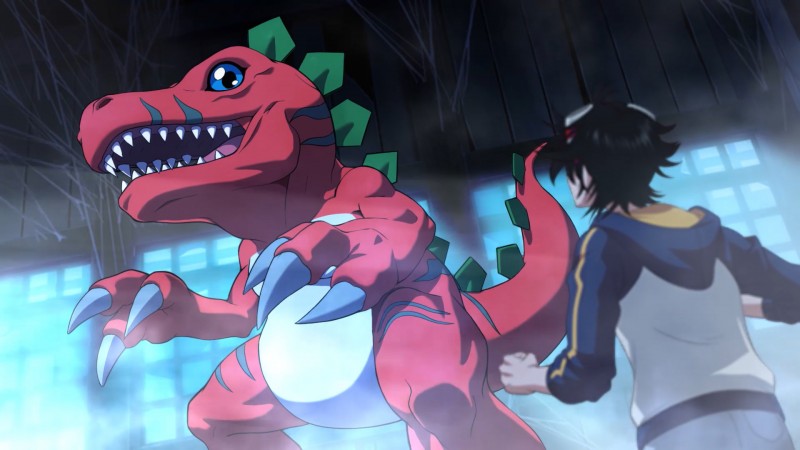In our group gathered after a tragedy, I try to calm down and plead that we should trust each other. Blood has been shed, and tensions are at an all-time high for this lost party of teenagers trapped in dangerous land. It’s not the scene I’ve ever imagined going through a visual novel based on the kid-friendly monster franchise in Digimon Survive, a tactical RPG. The dramatic dynamics in play are captivating, but the grid-based battles leave me snarling what could have been a compelling, complete package.
As a visual novel, Digimon Survive is an absolute treat, filled with beautifully crafted characters and scenes. Each location has well-crafted character with the camera pan and zoom, giving these places a sense of depth. I’m often put off by the sparse production values of visual novels, but Digimon Survive keeps the flow of dialogue visually interesting, enhanced by a partial Japanese voice-over.
You are put in the shoes of 14-year-old Takuma, who is herded by a cast of other young teenagers trapped in a dangerous world after getting lost on a school trip. Here, each child is linked through a mysterious bond with a fellow Digimon that hardly everyone accepts. This restlessness leads to several difficult situations that test the group’s trust in each other, their Digimon, and some characters’ grip on reality. While the story starts off slow, I am deeply impressed by the characters and learning the interactions and roles each one plays within the group.
First, I decided who would take my side, who would be anxious, who would be stubborn and stubborn, and who would be difficult or unbearable to deal with. I wouldn’t say I liked many characters for a while (or forever), which is great, and why Survive succeeds in its characterization and relationships. Throughout my play, I liked that I learned to deal with each character, telling them what they wanted to hear in a particular situation, or what they needed to be told for the betterment and survival of the group. The fate of these children’s lives is on the line, creating a pleasant tension. Even casual chats can lead to interesting turns for a character that can pull them back from the brink of being a problem for the team or put them on an anxiety-inducing path for everyone around them. can set.
Each child is accompanied by a Digimon that appears as the group enters this new dimension. The series mascot Agumon joins you while others like Floramon, Lopmon, Labramon, and Falcomon are tied to other recurring teens. These creatures play an important role in the story and are emotionally attached to human partners. I’m disappointed with some of the heavy development for the main Digimon, but overall, the interactions between you and the monsters are fun and rewarding. I really enjoyed learning how their budding friendship flourished or not, bringing powerful moments to the story that I’ll remember for a while.
Choices made through interaction can affect Digimon and will affect how they evolve, which is especially true with Agumon. Because emotions drive the relationship between partners, if your conversation choices lean toward one of the three traits of anger, morality, or harmony, the evolutionary tree of the augumon will change throughout the game. These choices also have extensive narrative implications, making for a good link between story structure and turn-based battles. I appreciate that my journey can have many different effects on my monsters, but the part of the game where development really matters is influenced by a lot more than the visual novel.
Digimon Survive’s tactical turn-based combat is overly simplistic and lacks excitement and strategy. Each Digimon can shuffle along the map grid to position attacks against enemy monsters. Digimon has a signature move and a basic attack, along with two additional equipped skills. My favorite part of skirmishes is the management. Using special attacks and assuming an evolved form consumes SP; Restores any precious resource remaining in base form for the main party’s monsters. Several times I had to combine development stages, which were stimulating and interesting, in order to preserve SP for a last-ditch attack. Still, it’s far from the norm when most battles take place away from mentally taxing encounters.
Rather than relying on team structure, formations, and strategically interesting attacks, most encounters simply result from getting your team closer to the opposition and impressing them with their strongest ability. There are, of course, fundamental advantages in play, and depending on whether you attack from the side or from the back side, can generate some additional destruction, but simple brute force usually gets the job done. As a result, the part of the game I was most excited to feel like the padding and bottom of the overall feel.
Fighting also allows additional Digimon to join your party, but the process is a tedious mess. These recruiting opportunities only come from free combat during exploration and require you to use the talk command to start a conversation. Enemy Digimon will ask you a series of three questions, each of which you must answer the way they like as many times as possible for a chance to be asked to join the team. It is clumsy and tedious, with multiple interactions resulting in failure. Despite my desire to have a cool new Digimon on my team, I eventually decided it was hardly worth the trouble.
I applaud Digimon Survive for being a dark, sad, and wonderful visual novel, and for reversing what I thought might be a Digimon story. While I want the combat to develop into the surrounding story presentation, it’s not enough to stop someone from seeing the narrative. Don’t expect a tactical masterpiece, but a well-made gloomy tale that depicts Digimon in a light they weren’t before.
